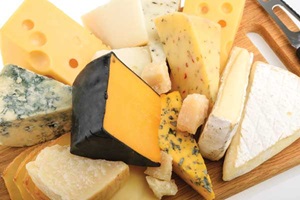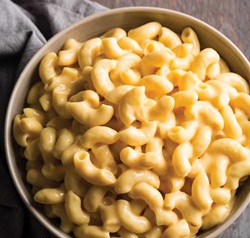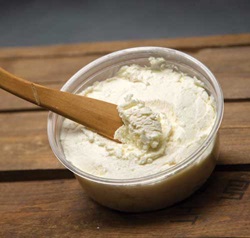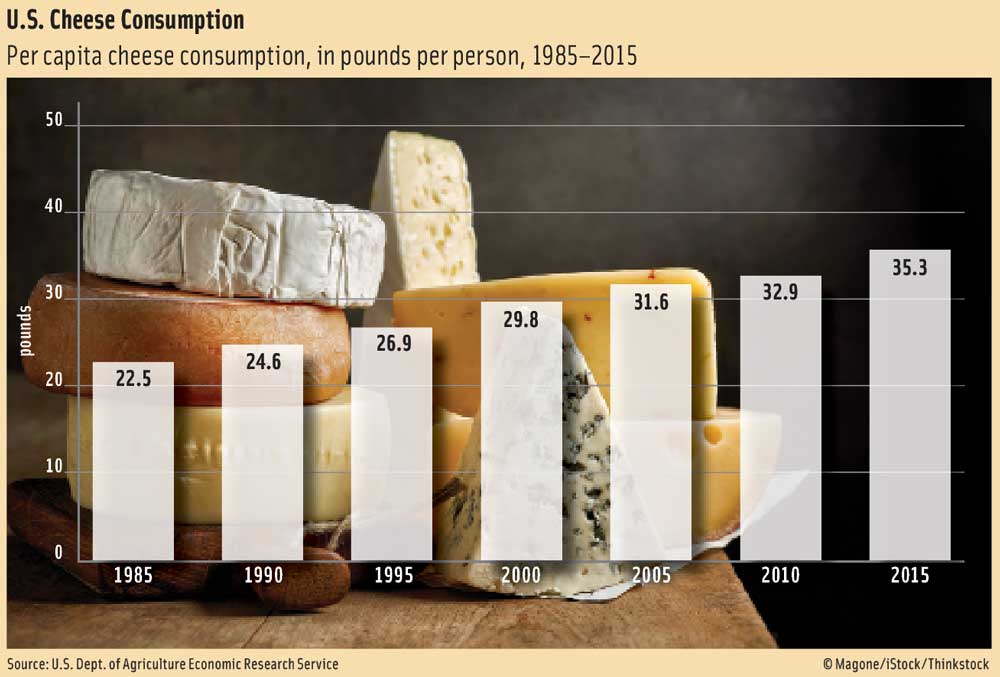Ingredients Improve the Art of Cheesemaking
INGREDIENTS
 Legend has it that an Arab nomad made the first cheese. He put his supply of milk in a pouch made from a sheep’s stomach before he set out across the hot dessert. The heat of the sun and the rennet in the lining of the pouch caused the milk to coagulate and separate into curd and whey. Imagine the surprise of the traveler when he discovered the new flavorful food. While this makes for a great story, researchers are not sure when or where the first cheese was made. It may date back to prehistoric times as researchers point to the discovery of milk residue found inside ancient pots and rudimentary tools thought to be cheese strainers (Salque et al. 2013). Travelers from Asia may have introduced cheesemaking to Europe, where it continued throughout the time of the Roman Empire and the Middle Ages, according to the International Dairy Foods Association. The early colonists to the New World brought cheese with them, and the making of cheese remained a local farm activity until European immigrants in the 1800s made their mark on cheesemaking, in part by opening cheesemaking factories to meet the growing demand.
Legend has it that an Arab nomad made the first cheese. He put his supply of milk in a pouch made from a sheep’s stomach before he set out across the hot dessert. The heat of the sun and the rennet in the lining of the pouch caused the milk to coagulate and separate into curd and whey. Imagine the surprise of the traveler when he discovered the new flavorful food. While this makes for a great story, researchers are not sure when or where the first cheese was made. It may date back to prehistoric times as researchers point to the discovery of milk residue found inside ancient pots and rudimentary tools thought to be cheese strainers (Salque et al. 2013). Travelers from Asia may have introduced cheesemaking to Europe, where it continued throughout the time of the Roman Empire and the Middle Ages, according to the International Dairy Foods Association. The early colonists to the New World brought cheese with them, and the making of cheese remained a local farm activity until European immigrants in the 1800s made their mark on cheesemaking, in part by opening cheesemaking factories to meet the growing demand.
“Luckily, cheesemaking today is not bound by age-old traditions, and U.S. cheesemakers are putting a unique spin on the process, allowing creative freedom to craft American originals and spiced-up classics,” says Amy Foor, director of export marketing programs at the U.S. Dairy Export Council.
Milk, salt, starter culture, and rennet are the four basic ingredients of cheese, but it is the cheesemaking process and how the ingredients are brought together that determine the finished cheese type, says Foor. “One minor alteration or finishing touch can vastly change the texture (crumbly, melt, stiff) and flavor of cheese. Modern American cheesemakers are doing just that and challenging traditional processes and recipes to create cheeses that have never been made before. This demonstrates the readiness of American cheesemakers to expand cheese varieties in unimaginable ways and make cheesemaking an artisan craft.” She adds that the industry is noted for its advancements in cheesemaking research and technology, such as the invention of individually quick-frozen mozzarella, which helps preserve the cheese’s freshness and stop the aging process to give foodservice operators and food manufacturers a consistent, high-quality product. “In addition, new technology over time has allowed American cheesemakers to exercise their creative intuition based on application type.” By this she means that cheesemakers can adjust their manufacturing processes to create cheese that meets the specific functional needs of their customers, such as customizing a cheese to have alternative melt, stretch, or browning characteristics.
In addition to the four basic ingredients, others such as hydrocolloids, starches, and even pulses are used to produce the variety of cheese products found in the dairy aisle and beyond, and this month’s Ingredients column will present a few of the recent ingredient developments in this category. But before that discussion, let’s find out what some experts in the cheese industry say are the trends and consumer demands that are driving the production of the different varieties of cheese and cheese ingredients available today. “The macro trends that are affecting the overall food and beverage industry definitely filter down to cheese and cheese ingredients,” says Jennifer Vega, natural and process cheese associate brand manager for Kraft Heinz Ingredients. “Consumers’ desires for convenient but authentic foods; short, familiar ingredient lines; and premium, natural products are top of mind for our scientists as they work on new product development.” Some of the company’s work, she says, addresses these trends by removing artificial colors and flavors from its products, optimizing emulsifier systems for product performance, texture, and flavor, and removing partially hydrogenated oils from cheese powders. “As the industry experts in process cheese, we have a dedicated team of scientists working on the next big bet for process cheese and continue to take into consideration the overall market trends as we target long-term innovation,” says Vega.
Another factor is the desire for authentic products, with consumers asking for more than just generic “cheese” as a flavor by wanting to know the specific variety and source of the product, such as Wisconsin white Cheddar, says KayLee Ryker, senior R&D food scientist at Kerry. Sustainable sourcing is also an important issue. “We work with customers so they can tell a farm to fork story with our dairy ingredients highlighting the actual farms from where our ingredients are sourced. Both trends stem from the consumer demand for greater transparency in the food they purchase and feed their families.”
Foor mentions that transparency is important, with consumers wanting food that they can trust, but that they also want options that offer bold flavors. “For both food products and menu items, consumers want craft options from recognizable ingredients with transparency on where it comes from. The United States has a long and enviable history of manufacturing safe cheese and dairy products, and the innovative spirit of American cheesemakers is increasing the ability to give classic cheeses an authentic flavor, meeting consumer trends. Additions such as rubs and nontraditional ingredients add a level of depth to cheese, and, in turn, a tasty twist to meal items.”
Lastly, Foor points out that both consumers and food manufacturers are interested in the nutritious ingredients and wellness characteristics that cheese provides. In addition to flavor, cheese is a source of calcium and protein, and it is added to snack and meal products to increase the amount of protein to meet consumer consumption needs, she says. Something else she notes is that lactose-intolerant consumers may be able to consume certain natural cheeses such as Cheddar, Colby, Monterey Jack, mozzarella, and Swiss because the cheesemaking process naturally removes lactose during the separation of cheese curds from the whey.
 Clean Label Friendly
Clean Label Friendly
As consumers become increasingly vocal about the types of ingredients in food and beverage products, food manufacturers are removing artificial ingredients or ones with unfamiliar names and replacing them with ingredients that have a clean label feel. To provide the smooth, creamy melt of a processed cheese without the additives that are common in those types of products, Kerry recently introduced a clean label spread-type cheese product.
Ryker explains that the Kerry Clean Label Cheese Solution is made without emulsifiers, emulsifying salts, hydrocolloids, artificial flavors, and artificial preservatives and has a label declaration that simply reads Cheddar cheese, skim milk, salt, food starch, cultured whey, and cultured skim milk. The ingredient is very versatile and is said to perform similarly to a processed cheese. “The product can be used in a variety of applications, the most common being soups, sauces, and dips. It works exceptionally well in macaroni and cheese, as well as queso dips. The product also performs well in cheese products that have to be held on a steam table.” It’s simple to use; food formulators use the ingredient the same way they that they use processed cheese in current formulations, says Ryker. At the IFT17 food expo, the company served a Clean Label Queso Dip made with Kerry Clean Label Cheese Solution.
Other Kerry cheese ingredients that meet clean label demands are organic, Non-GMO Project Verified dairy powders for manufacturers wanting non-GMO certification and the Intensified Dairy Taste line that delivers cheese and dairy tastes without adding flavors of enzyme modified cheeses to food labels. “Intensified Dairy Taste provides aged, fermented, and creamy flavor inherent to dairy with a simple ingredient statement,” says Ryker. “Only real cheese and dairy products are used … and therefore can be claimed on the label.”
 Getting Cultured
Getting Cultured
Without starter cultures in the cheesemaking process, milk is just milk. The tiny bacteria play a huge role in cheesemaking, from fermenting milk sugar to produce lactic acid, to lowering the pH of the milk and curd, to affecting the final flavors of the cheese. DuPont Nutrition & Health has added two new culture ingredients to its CHOOZIT line for producing Cheddar cheese and American-style cheeses such as Colby and Jack.
The first is a frozen Cheddar culture range called CHOOZIT M3. “The CHOOZIT M3 allows cheesemakers to use this one culture system for producing mild, medium, or mature Cheddar with traditional savory flavor development,” says Jeff Lambeseder, regional product manager, cultures, at DuPont Nutrition & Health.” In addition, the M3 offers built-in protection against bitterness thanks to a specially selected Lactobacillus helveticus strain included in every package.” The other is CHOOZIT AMERI-FLEX frozen culture system made with a blend of fast-acidifying mesophilic and thermophilic cultures. “The CHOOZIT AMERI-FLEX range is designed with eight rotations in two different activity levels to give cheese-makers exceptional flexibility under challenging processing conditions common to very large-scale production,” adds Lambeseder.
One of the biggest difficulties that cheesemakers face is making sure each batch is uniform, and that’s where the CHOOZIT cultures can help. “Achieving consistency from day to day and vat to vat is a big challenge—to be certain that the cheese will hit the correct initial targets for moisture, pH, and solids. This is critical to get the correct cheese to build a brand or deliver what their customers want,” explains Lambeseder. One helpful quality of the CHOOZIT cultures, he adds, is that they deliver a consistent acidification performance. “This is important to remove a source of potential variation from the cheesemaking process. We also sell special ripening cultures we call flavor adjuncts; these will help to ensure the cheese develops the correct flavor and texture during the ripening phase of cheesemaking.”
Another benefit of the CHOOZIT cultures is their clean label qualities. As Lambeseder explains, “Our CHOOZIT cultures fit very well with clean label, but we see more requests asking us to confirm that our cultures are made with non-GMO ingredients and rBST-free dairy sources. We also see more customers looking to create their own signature cheese flavor, whether it be an aged Cheddar or something more reminiscent of a traditional Alpine cheese. One big advantage we have at DuPont Nutrition & Health is a global network of colleagues and specialty CHOOZIT cultures that allow us to help cheesemakers create a very authentic tasting, European-style cheese.”
Cultures are not the only ingredients for cheesemaking that DuPont Nutrition & Health produces; it also offers enzymes and ingredients to extend the shelf life of cheese. Its enzyme MARZYME is derived from fermentation on a replenishable vegetable substrate, says Lambeseder. “MARZYME is added after the cultures in the cheesemaking process to coagulate the milk protein and is completely non-GMO, suitable for vegetarian and organic cheese production with our preservative-free versions.” MICROGARD and NATAMAX protect cheese from spoilage microorganisms, delivering shelf-life extension benefits. MICROGARD is a fermentation-based shelf-life extender that protects against yeast, mold, and certain bacteria in cottage cheese and can be labeled as cultured skim milk while NATAMAX, which is derived from non-GM fermentation, helps prevent yeast growth. Lambeseder adds that both ingredients also have the added benefit of fitting into the clean label trend.
Plant-Based Enzyme Alternative
The milk-clotting enzyme rennet congeals milk and creates a gel-like mass, which is then cut to separate the whey from the curd. Typically, two types of rennet are used: animal rennet (derived from the stomachs of calves) and microbial rennet. Enzyme Development Corp. offers a third type of rennet called Cynzime, an aspartic acid protease derived from the Cynara cardunculus flower (thistle flower).
The use of this thistle rennet is not new and has been documented as early as the Roman Empire when it was used to produce cheese in Portugal and Spain, says Christina S. Barsa, technical sales representative at Enzyme Development Corp. “Individual farmers would collect the thistle flowers when they were in season and dry them. When the farmers were ready to produce cheese, they would brew the dried leaves into a ‘tea.’ The amount of ‘tea’ added to the milk in the cheese recipes would require a great amount of trial and error, as the enzyme activity in the ‘tea’ would vary from year to year and from person to person preparing it. This process could lead to the thistle rennet having a very high activity or a low activity. The variation in the activity of homemade thistle rennet may be one of the primary reasons that it is often reported as causing bitter flavors. Bitter flavors due to protein hydrolysis are often the result of overdosing the proteases.”
 Today, thistle rennet, in the form of Cynzime, is much easier to use than the thistle rennet used during the Roman Empire and offers cheesemakers several benefits. Here, Barsa explains how Cynzime works. “All rennet products are proteolytic enzymes. In a typical animal rennet or microbial rennet, the enzyme slits the amino acid chain of kappa-casein, producing para-kappa casein. The cut ends of the para-kappa casein link with phosphate and calcium minerals present in milk, forming a bridge to other casein molecules, forming the curd. Cynzime is different from animal and microbial rennet products, as it not only cleaves the kappa-casein, but also the αs, β, and γ casein.” Since Cynzime hydrolyzes all the casein bonds, she says, it produces cheese with a smooth texture. And the enzyme is from a plant source, so it can be used in both kosher- and halal-certified cheese and it meets dietary restrictions that prevent meat and milk being consumed together.
Today, thistle rennet, in the form of Cynzime, is much easier to use than the thistle rennet used during the Roman Empire and offers cheesemakers several benefits. Here, Barsa explains how Cynzime works. “All rennet products are proteolytic enzymes. In a typical animal rennet or microbial rennet, the enzyme slits the amino acid chain of kappa-casein, producing para-kappa casein. The cut ends of the para-kappa casein link with phosphate and calcium minerals present in milk, forming a bridge to other casein molecules, forming the curd. Cynzime is different from animal and microbial rennet products, as it not only cleaves the kappa-casein, but also the αs, β, and γ casein.” Since Cynzime hydrolyzes all the casein bonds, she says, it produces cheese with a smooth texture. And the enzyme is from a plant source, so it can be used in both kosher- and halal-certified cheese and it meets dietary restrictions that prevent meat and milk being consumed together.
Cheese manufacturers use Cynzime in a similar way that they would an animal or microbial rennet, says Barsa. The milk takes a little longer to coagulate when Cynzime is used versus an animal or microbial rennet, so manufacturers will need to combine the milk ripening step with the coagulation step, she adds. Something else to note is that more mixing is required to ensure that Cynzime is completely dispersed into the milk (animal and microbial rennets tend to require little mixing).
While homemade thistle rennet has a wide variation in its activity level, as Barsa mentioned, Cynzime is standardized so that it has the same activity in every lot. “The method we use for testing the activity of the enzyme is the milk clot assay. The assay measures the activity of the protease by determining the amount of product needed to clot standardized milk in a set time, at a set temperature, and pH. This removes the trial and error on amount of rennet needed during cheese production.”
Cynzime is used to coagulate milk during the production of many varieties of cheese. Some of the more well-known cheeses made with thistle rennet are Portuguese cheeses from sheep milk (Serra da Estrela, Serpa, Azeitão, Nisa, Castelo Branco, and Évora), Spanish cheeses from goat milk (Los Ibores and Flor de Guía), and sheep milk cheeses (Casar de Cáceres, Torta del Casar, and La Serena), says Barsa. But the enzyme is not limited to these types of cheeses. “We have been working with a cheesemaker with the enzyme, and he makes a variety of cheese with it: a French reblochon, butterkäse, fromage blanc, Swiss Appenzeller, queijo fresco, blue cheese, and Parmesan cheese.”
Enzyme Development Corp. demonstrated the functionalities of Cynzime in three cheeses it showcased at the American Cheese Society 2017 conference. The cheeses—RDB, a soft cheese inspired by French reblochon; German butter cheese, a semisoft cheese adapted from a German butterkäse recipe; and graters, a Parmesan-style cheese with a slight herby note—were made by Winding Road Artisan Cheese. Barsa says that the RDB cheese won second place in the category Soft-Ripened Washed Rind-High Moisture Over 42%—All Milks in the ACS Judging & Competition held at the conference.
Cheese Ingredient Options Expand
With a portfolio of more than 85% cheese and cheese ingredients, Kraft Heinz Ingredients is well prepared to provide a wide variety of solutions to its customers. “This includes tasty cheese powders, such as our line of CheezTangs, highly concentrated Cheddar cheese powders; our Old English process cheese, a sharp Cheddar process cheese with natural colors; and our broad portfolio of cream cheeses. Kraft Heinz Ingredients can deliver powerful ingredients targeted to supply all levels of cheese in applications,” says Vega.
The company’s natural and process cheese portfolio consists of three categories: natural, club cheese, and process cheese. “Our natural cheeses are known for their rich and unique flavor and are increasing in demand as consumers are trending more toward natural and clean ingredient lines,” says Vega. Its club cheeses are made by grinding various natural cheeses together into one mass without the aid of heat, and they are often used as a flavor booster. “Club cheese, typically a more premium product, can be used in smaller amounts and still provide higher/heavier notes of cheese content.” The final category is process cheeses. Vega explains that whether they are standard of identity (SOI) products or specialty (non–SOI) products, they provide unique functionality, such as a smooth, melted texture to different food manufacturers depending upon their end application. “For instance, our SOI pasteurized process cheese spreads are a great option for customers making soups, sauces, dips, and quesos; our melt-restricted specialty line is excellent for applications such as appetizers or meat inclusions.”
 Producing cheese begins with the milk (sheep, goat, or cow are commonly used). For natural cheese, the end product varies in both form and flavor depending on the cultures, aging, make process, and origin, while standard of identity process cheese always starts with natural cheese and is then further processed with the aid of emulsifying salts and the application of heat, in combination with other ingredients such as water, color, acid, and salt to achieve a desired flavor and performance, says Ryan High, director of R&D at Kraft Heinz Ingredients. “From improving the melt characteristics to reducing oiling-off to providing a smooth, creamy mouthfeel, these are all common reasons to use a process cheese rather than a natural cheese. Kraft has been making process cheese since the early 1900s, and with such a deep background in and understanding of process cheese chemistry, our expert developers can ‘tune’ process cheese to meet the various needs of our customers.” All the company’s cheeses are made with its proprietary cultures and are aged and graded to its standards, he says. Both natural cheese and process cheese ingredients are regulated by the U.S. Code of Federal Regulations (CFR 133 for natural cheese, CFR133.123 for club cheese, CFR 133.169 for process cheese, and CFR 133.175 for SOI pasteurized process cheese spreads).
Producing cheese begins with the milk (sheep, goat, or cow are commonly used). For natural cheese, the end product varies in both form and flavor depending on the cultures, aging, make process, and origin, while standard of identity process cheese always starts with natural cheese and is then further processed with the aid of emulsifying salts and the application of heat, in combination with other ingredients such as water, color, acid, and salt to achieve a desired flavor and performance, says Ryan High, director of R&D at Kraft Heinz Ingredients. “From improving the melt characteristics to reducing oiling-off to providing a smooth, creamy mouthfeel, these are all common reasons to use a process cheese rather than a natural cheese. Kraft has been making process cheese since the early 1900s, and with such a deep background in and understanding of process cheese chemistry, our expert developers can ‘tune’ process cheese to meet the various needs of our customers.” All the company’s cheeses are made with its proprietary cultures and are aged and graded to its standards, he says. Both natural cheese and process cheese ingredients are regulated by the U.S. Code of Federal Regulations (CFR 133 for natural cheese, CFR133.123 for club cheese, CFR 133.169 for process cheese, and CFR 133.175 for SOI pasteurized process cheese spreads).
Food manufacturers are formulating a wide range of applications, from traditional comfort foods such as soups and macaroni-and-cheese dishes to more creative handheld appetizers, says Vega. And they are also getting creative in their product offerings. “Our customers are innovating by using nostalgic dishes and recreating them with a twist. A mac-and-cheese bite or a lobster-and-bacon mac and cheese are a few examples of how this classic dish is reinvented to reach all generations. Whether it’s making a new portable, on-the-go snack, upscaling a popular application or designing a better-for-you version of a dinner staple, Kraft Heinz Ingredients is able to leverage its portfolio breadth in order to partner with its customers in new product launches.”
Next month’s Ingredients section will discuss ingredients for food preservation and food safety.
 Karen Nachay,
Karen Nachay,
Senior Associate Editor
[email protected]
References
Salque, M., P. I. Bogucki, J. Pyzel, et al. 2013. “Earliest Evidence for Cheese Making in the Sixth Millennium BC in Northern Europe.” Nature 493: 522–525.



 Ingredion’s pulse ingredient portfolio is made up of VITESSENCE pulse proteins and HOMECRAFT pulse flours derived from faba, pea, lentil, and chickpea. They provide several benefits to alternative dairy cheese products. “The first attribute that gets improved is the nutritional aspect as the majority of alternative dairy cheeses are very low in protein content,” says Gonzales. “By incorporating pulse ingredients, and more specifically pulse proteins, we can help improve the nutritional profile of alternative dairy cheeses. Pulses can also help improve firmness, which translates to improved shredding properties.”
Ingredion’s pulse ingredient portfolio is made up of VITESSENCE pulse proteins and HOMECRAFT pulse flours derived from faba, pea, lentil, and chickpea. They provide several benefits to alternative dairy cheese products. “The first attribute that gets improved is the nutritional aspect as the majority of alternative dairy cheeses are very low in protein content,” says Gonzales. “By incorporating pulse ingredients, and more specifically pulse proteins, we can help improve the nutritional profile of alternative dairy cheeses. Pulses can also help improve firmness, which translates to improved shredding properties.”